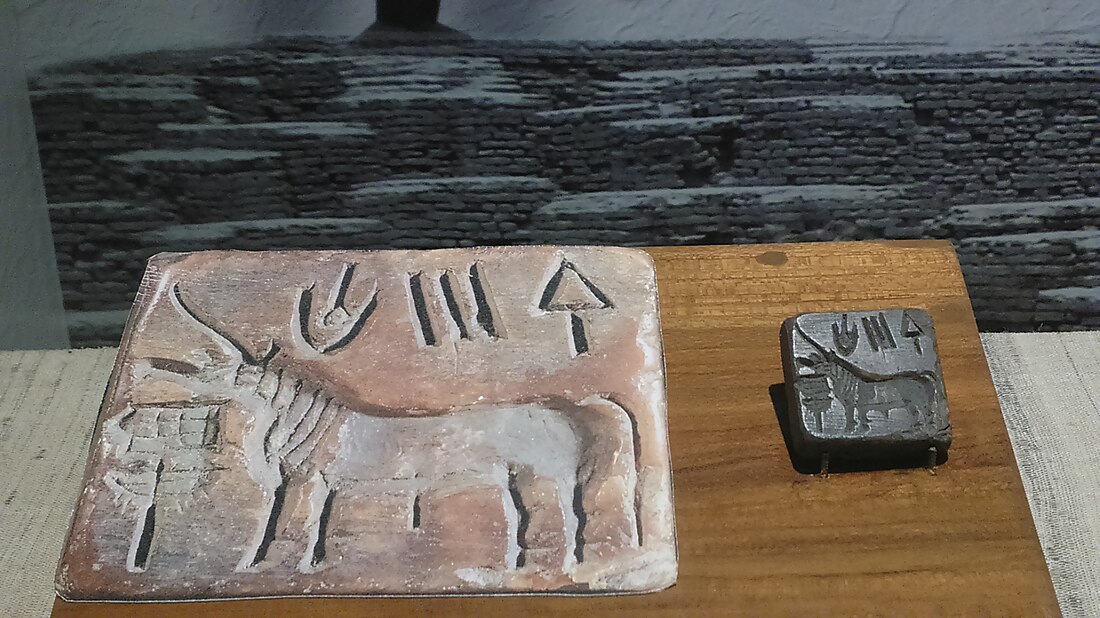Indus script
script, short strings of symbols associated with the Indus Valley Civilization From Wikipedia, the free encyclopedia
Remove ads
Indus script is a collection of symbols that was used by the Indus Valley Civilization in what is now Pakistan and north-west India. The symbols were used from about 2500 BC to about 1900 BC. Most inscriptions are extremely short. About 400–600 different symbols are known.


Scientists do not agree if these symbols are a real writing system that can record a whole spoken language, or if they are a more simple system of signs. So far no bilingual text has been found. A bilingual text is a text written in two languages. A famous example is the Rosetta Stone, which has the same text written in three different scripts.
Remove ads
Inscriptions and signs
Most Indus symbols are known from small stone seals. These seals are usually about 2–3 cm wide and show one line of symbols and an animal, such as a bull, elephant, or a unicorn-like animal. The symbols are also found on clay sealings (seals pressed into clay), on pottery, and on a few copper plates and tools.
The texts are very short. Many have only 3–5 signs. The longest known text has about 30 signs. This makes it hard to know how the system worked.
The symbols have many different shapes. Some look like people, animals, plants, or tools. Others are simple marks, like lines or circles. Some symbols may be joined together to make more complex signs.
Remove ads
Direction of writing
Most experts think that Indus symbols were usually written from right to left. On many seals, the symbols are closer together or squeezed on the left side, as if the writer ran out of space at the end of the line. When the seal is pressed into clay, the image is reversed, so the impression can be read from right to left.
Ideas about the script
Because the script has not been deciphered, there are many ideas about what it is:
- Some scholars think the symbols are a full writing system that recorded a language. One common idea is that the language was an early form of the Dravidian language family.
- Other scholars think the script might show a different language, or even a language that has no living relatives today (a language isolate).
- Another group of scholars thinks that the symbols are not full writing at all. They may be non-linguistic signs, for example marks that show families, clans, gods, or religious ideas, a bit like marks on coats of arms.
A recent study has suggested another idea. It argues that many Indus inscriptions were merchant marks, used in trade and record-keeping. In this view, the signs would often show the owner, the type of goods, or a weight or number, rather than full sentences in a language. The study also suggests that a famous long signboard from the city of Dholavira may show parts of an animal-drawn cart in order, like a large label or shop sign, and not a normal line of text.[7]
Attempts to read the script
Many people, both professional scholars and amateurs, have tried to read the Indus script. More than one hundred different readings and theories have been published. So far, none of these attempts has been accepted by most experts.
Because the texts are so short, and because we do not know for sure which language was spoken in the Indus Valley, it is very difficult to test any proposed reading. Until a clear bilingual text is found, or many longer texts are discovered, the Indus script will probably remain undeciphered.
Remove ads
Related pages
- Indus Valley Civilization
- Harappan language
- Writing system
References
Wikiwand - on
Seamless Wikipedia browsing. On steroids.
Remove ads

